KIN 300 Test #2
Muscle Functions
-movements essential for basic survival
breathing
running away from danger
Types of Muscles
Skeletal Muscle
-regulates body temperature
-attach to bones to bones
some attach one side to bone and another side to skin
muscles in face → bone to skin
-movement at joints
-voluntary control & involuntary control
-accounts for significant portion of body weight
Cardiac Muscle
-cardiac system
heart (contractions)
-involuntary control
can’t purposefully contract heart
Smooth Muscle
-digestive tract
-involuntary control
Muscle Properties
Electrical Excitability
-conducts electrical impulses
Contractility
-contraction
-generates tension within muscle
-generates force on whatever its attached to
Extensibility
-passive properties
-can extend
Elasticity
-passive properties
-can stretch
Levels of Organization in Human Body
-cell division & growth
Specialized Cell Types
-muscle
-neurons (nerve)
-connective tissue cells
ligaments & tendons
-epithelial cells
line blood vessels, overall structure of cells
Organ (Skeletal Muscle)
-muscle tissue
-connective tissue
-nervous tissue
-blood/vascular tissue (endothelial)
endothelial under category of epithelial
-organ ends up in
musculoskeletal system
neuromuscular (nervous) system
-each muscle is an organ
quads, biceps, triceps
Connective Tissue Components
Superficial Fascia
-holds everything in place
-in subcutaneous layer of skin
Deep Fascia
-beneath subcutaneous layer
-protect muscle
-conduit for nerves and muscles
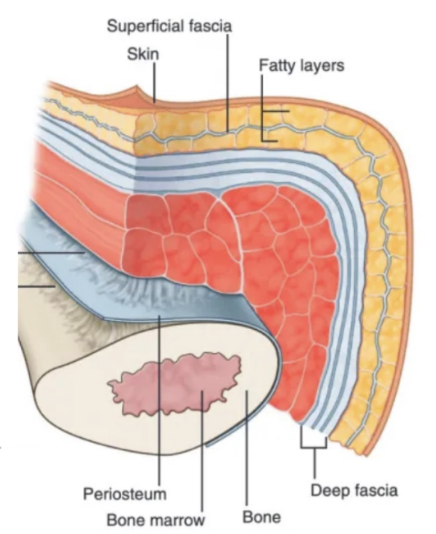
Deep Connective Tissue Components
Tendons
-attaches muscle to attachment point (usually bone)
Aponeurosis
-type of tendon
Muscles Connect to Our Skeleton → Movement
-when a muscle contracts, it generates tension and exerts force on the skeleton to move our body
-muscle contracts to generate force to allow a movement
-muscle attachment is across a joint to allow for movement
muscle attachments have to cross the joint to cause movement at the joint → cannot attach the same bone
concentric contraction, results in 2 bones moving closer to each other
bending the elbow, wrist, hip = concentric usually, but not all the time
Microscopic Anatomy of Muscles
-skeletal muscle → fascicle → muscle fibers (cells) → myofibrils
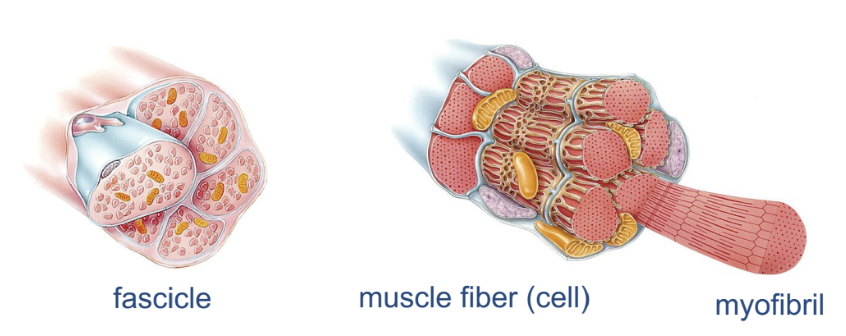
-muscle cell plasma membrane → sarcolemma
-muscle cell intracellular fluid/cytoplasm = sarcoplasm
-muscle cell contractile organelle = myofibrils
*muscle fiber = muscle cell
Sarcomere
-functional unit of muscles
how contractions occur
all sarcomeres contract simultaneously → whole muscle contraction
-filaments arranged in compartments
thin & thick filaments
repeat in sequence
thin filament within thick filament
alternating within the sarcomere
slide along each other during contraction
don’t shorten or change length
thin filaments slide over thick filaments
-contractile unit of skeletal muscle
gives striated appearance to muscle (feature of muscle cell)
striped look under microscope
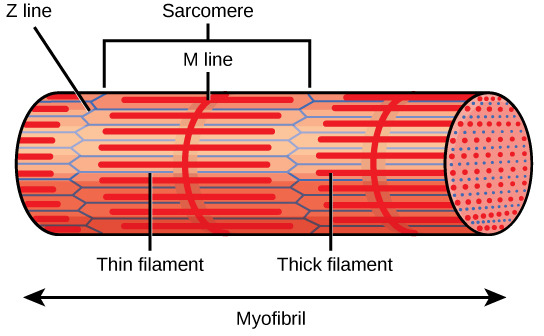
Thick Filaments
-made of myosin proteins
tail points towards center
globular heads points outwards

Thin Filaments
-actin, troponin, tropomyosin proteins

Actin
-molecules in helical arrangement
Troponin
-secures the position of tropomyosin over actin
-holds everything together/keeps everything in place
-3 binding sites
binds to calcium ions
released into sarcoplasm when muscle fiber is activated
when Ca binds to troponin → changes structure
loosens grip
binds actin and myosin together
Tropomyosin
-when at rest, blocks actin from binding to myosin
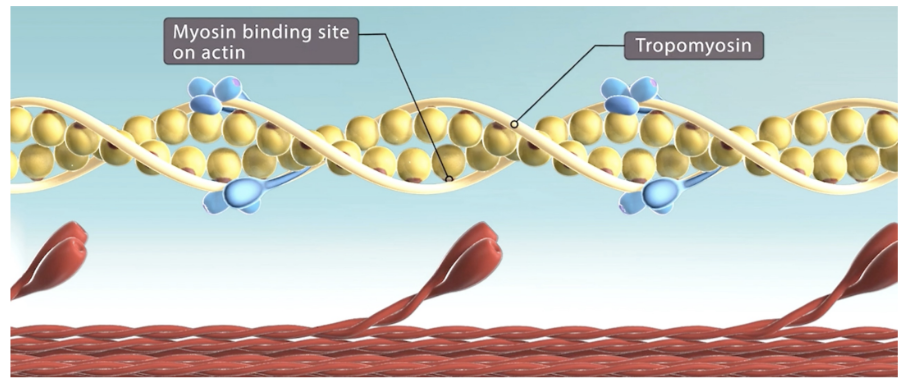
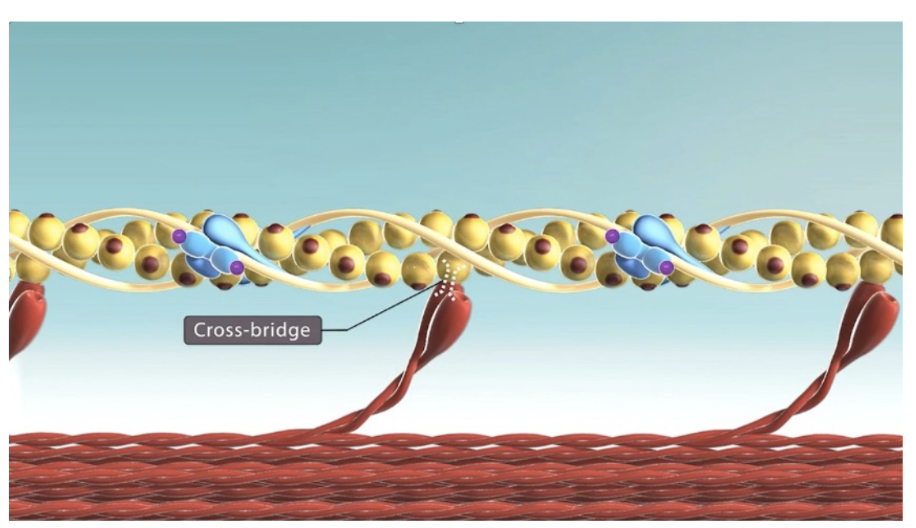
Activated Filaments
-calcium is released from the sarcoplasmic reticulum into the sarcoplasm when muscle contracts
-cross-bridge forms when myosin binds to actin
Feature of Muscle Contraction
-how much tension is produced
how much force generating power muscle has
-how quickly the tension rises (speed of contraction)
depends on type of myosin protein in the muscle fiber type
how quickly myosin head can catalyze
how long the contraction can be maintained
endurance/fatigability
-muscle contraction → generates tension → strength
amount of tension directly related to number of cross-bridges formed
more cross bridges/bonding = more tension = stronger = more proteins
amount of bonds that can be made between myosin and actin
Muscle Contraction Cycle
-when muscle at rest → tropomyosin blocks actin from binding to myosin
-during neural stimulation → ATP & Ca present
calcium is released into muscle cell from sarcoplasmic reticulum
calcium binds to troponin and causes a change in troponin
troponin shape change moves tropomyosin out of the way
actin’s binding site is no longer blocked
myosin heads from thick filaments can bind to actin in thin filaments
myosin pulls actin inward and makes muscle contract
second ATP attaches to myosin head → myosin is released from actin
binds to new actin if possible
-myosin head contains enzyme that breaks down ATP
-ATP provides energy for powerstroke & allows cycle to continue (new ATP each time)
2 ATP used
a new ATP comes in → triggers and binds to new myosin
Muscle Metabolism
-ATP is fuel for cross bridge/contraction cycle
-how muscles generates the ATP necessary to power the contraction cycle
anaerobic creatine phosphate (phosphocreatine)
aerobic cellular respiration
anaerobic glycolysis
Creatine Phosphate
-short burst of energy
-short amount of energy (~15s)
-anaerobic process (no oxygen involved)
eg. 100 m dash (power output to do the sprint)
-body stores creatine phosphate to allow 15s of burst of energy
quick and convenient way of manufacturing ATP in muscle
fast acting system
-made from meat, dairy products
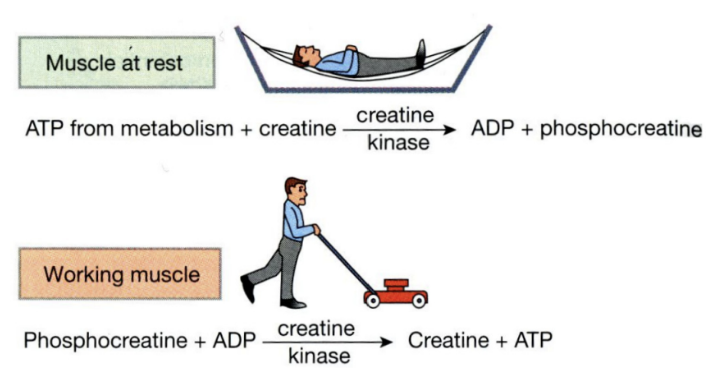
Glycolysis
-anaerobic process (no oxygen involved)
-breaking down glucose
glycolysis
1 glucose molecule = 2 molecules of ATP
Cellular Respiration
-aerobic process (oxygen involved)
-mitochondria produces ATP
-oxygen from hemoglobin blood/from myoglobin in muscle fibers
-lots of ATP produced
-powers long term sustained activities
powers endurance activities
Muscle Fiber Types
Type I
-slow oxidative (SO) fibers
-aerobic
-long distance/endurance
Type IIa
-fast oxidative-glycolytic (FOG) fibers
-aerobic/anaerobic
-short distance activities
Type IIx (IIb)
-fast glycolytic (FG) fibers
-intermediate
-anaerobic
Muscle Contraction Types
Tension
-determined by opportunity to form cross-bridges
-proportional to number of cross-bridges formed
-size factor
muscle fibers differ in size, diameter
large diameter = more filament proteins = more cross bridges
-other factors influence tension on contraction-by-contraction basis
mechanical factor
amount of overlap between thick and thin filaments → length of muscle
neural factor: amount of calcium released into the sarcoplasm → depends on neural stimulation
Type I
-smallest diameter → less tension
-least powerful
-good for endurance (rich blood supply)
lots of myoglobin
lots of mitochondria → huge capacity for generating ATP
Type IIa
-largest diameter → more tension
-very powerful
-good for short distances
Type IIx
-intermediate muscle fiber diameter
-force output is greater than Type I, less than Type IIa
Fatigability
-determined by supply of ATP
Type I
-high capacity for aerobic cellular respiration
-fatigue-resistant (high endurance performance)
Type IIa
-relies on anaerobic processes for ATP
-fatigable (low endurance)
Type IIx
-relies on aerobic and anaerobic systems for ATP
-not as fatigable as Type IIa but less endurance than Type I
Speed of Contraction
-determined by speed of cross-bridge cycling
Type I
-ATPase enzyme activity in myosin heads relatively slow in Type I fibers myosin heavy chain isoform
-slow speed of contraction
Type IIa
-ATPase activity in myosin heads very fast
-fast contraction speed
Type IIx
-intermediate
-not as slow as Type I but not as fast as Type IIa
Energy Systems Over Time
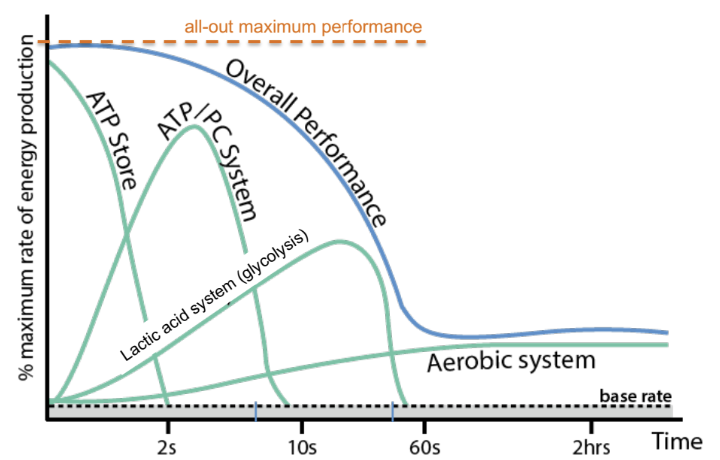
Energy Continuum
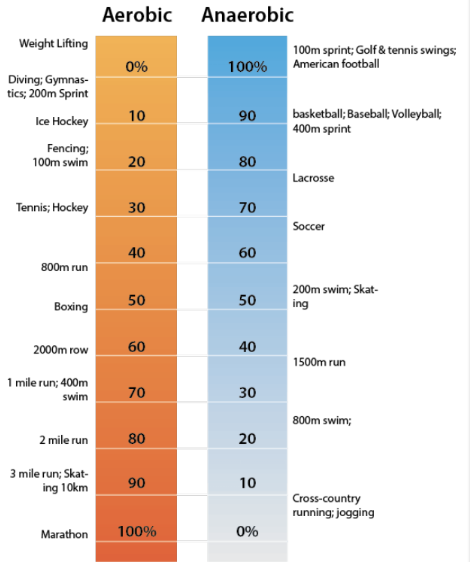
-power athletes rely on anaerobic systems
Type IIa fibers
high % of FG fibers
100 m dash
light lifting
-long endurance athletes rely on aerobic systems
Type I fibers
high % of SO fibers
marathon runners
heavy lifting
Length-Tension Relationship
-muscles for gripping
originates in forearm and crosses your wrist to reach fingers
neutral wrist → optimal length of finger flexor muscles
flex wrist → shortens finger flexor muscles
extend wrist back → lengthens finger flexor muscles
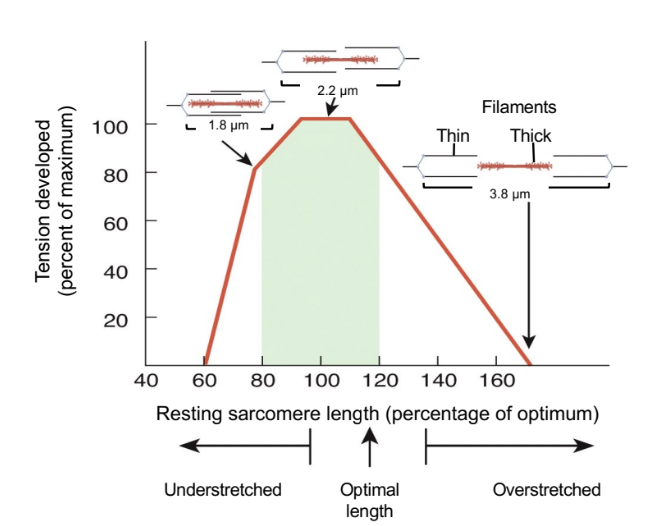
-when muscles stretch → less overlap of thin and thick filaments
-muscles travel through forearm
-hand → bend downwards → muscle shorter
-hand → bend backwards → muscle longer
Sticking Point
-part of range of motion in a resistance exercise where there is a large increase in the difficulty level to continue the lift
if exercise is performed to exhaustion → failure is experiences around vicinity of sticking point
-could be related to length-tension relationship
Neural Input to Skeletal Muscle
-motor neurons located in spinal cord
transmits impulses from nervous system to muscle fibers
-nerve cells/neurons
alpha-motor neurons
-electrical impulses gets transmitted to muscle fibers to release calcium
-neural firing → neuromuscular junction → release of calcium into sarcoplasm → contraction cycle
Neuromuscular Junction
-link (synapse) between motor neuron & skeletal muscle fibers
-cell to cell
nerve cell connects to muscle cell
Motor Unit
-1 motor neuron + all the muscle fibers it innervates (connects to)
each motor neuron is responsible for a given set of muscle fibers
-one motor unit has branches and connects to muscle fibers
-everytime a neuron fires an electrical impulse → generates response in muscle
1 nerve impulse → x amount of tension in muscle fiber
-no big or small nerve impulses
all nerve impulses are identical and always the same
amount of tension that gets generated is the same
Motor Units Have Different Sizes
-small motor units
muscles for fine movements
eyeball moving, singing
made of Type I muscle fiber units
higher endurance
-large motor units
muscles for powerful movements
kicking a ball, lifting weights
made of Type II muscle fiber units
more powerful
-orderly recruitment of motor units
recruit from small motor units to large motor units
as you need more power → go from Type I to Type II muscle fiber units
heavy lifting: Type I to Type IIa to Type IIx
-muscle fibers switch from Type IIx to Type IIa with training
because Type IIx fatigue easily
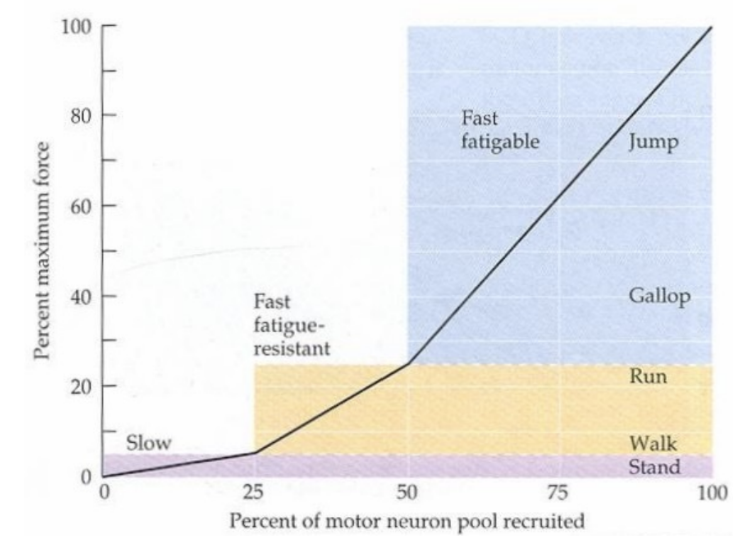
-to increase muscle tension, nervous system can do 2 things
increase number of motor units recruited
increase firing rate (frequency) of motor neurons (motor units)
-large units may not be recruited
Motor Units are Active “At Rest”
-always background (low level) motor unit/neural activity
-gives us muscle tone
otherwise muscles would be flaccid/hypotonic
-motor units are always firing steadily
Neural Contribution to Muscle Tension
-each muscle fiber is innervated by 1 motor neuron
-neuromuscular system can increase tension
increase frequency of stimulation
recruit more motor units (recruit more muscle fibers)
-small motor unit = small amount of muscle fibers connect to muscle neuron
-large motor unit = lots of muscle fibers can connect to muscle neuron
Effect of Firing Frequency (Frequency-Tension Relationship)
-faster the firing frequency, more tension can build up in the muscle fiber
-faster frequency = more tension that can build up
Muscle Twitch
-single stimulus contraction-relaxation sequence in one muscle fiber
-1 nerve impulse → 1 muscle twitch
Recruitment
-skeletal muscle contains 1000s of muscle fibers (cells)
-each muscle fiber is supplied by 1 motor neuron
but each motor neuron supplies several muscle fibers
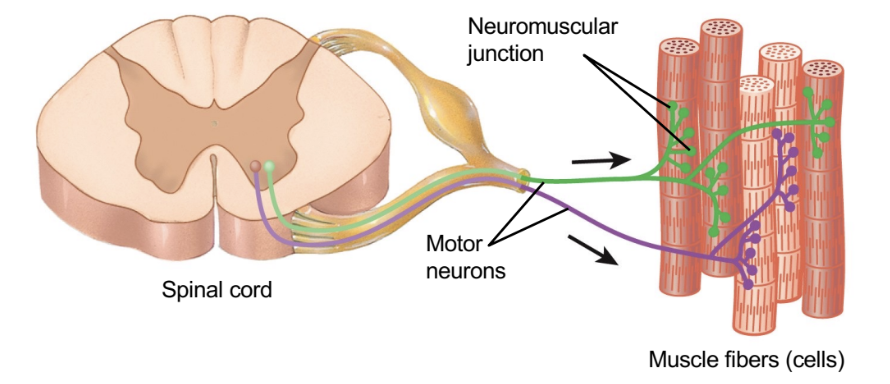
Initial Effects of Strength Training Program
-initial effects of training are neural adaptations
first thing that adapts in body is neural adaptation
improvement of background tone of motor unit firing
first thing enhances is neural input
allows you to keep going at baseline
changes in actual muscle fibers (hypertrophy) after a few weeks
more motor neurons at rest = burning more energy
weight training important for weight loss
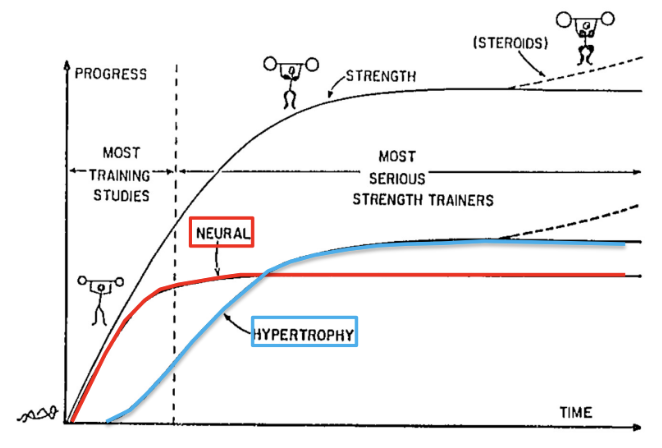
Fuel Utilization at Different Exercise Intensities
-exercise intensity drives carbohydrate use
-muscle glycogen rarely used at 65% VO2 max (low intensity training)
used more at 85% VO2 max (high intensity training)
Types of Carbohydrates to Increase Carbohydrate Oxidation
-figure out which sugar is best for exercise
Oxidation of Infused Carbohydrate
-infusing glucose → bypassing GI tract
straight to bloodstream instead of waiting for absorption
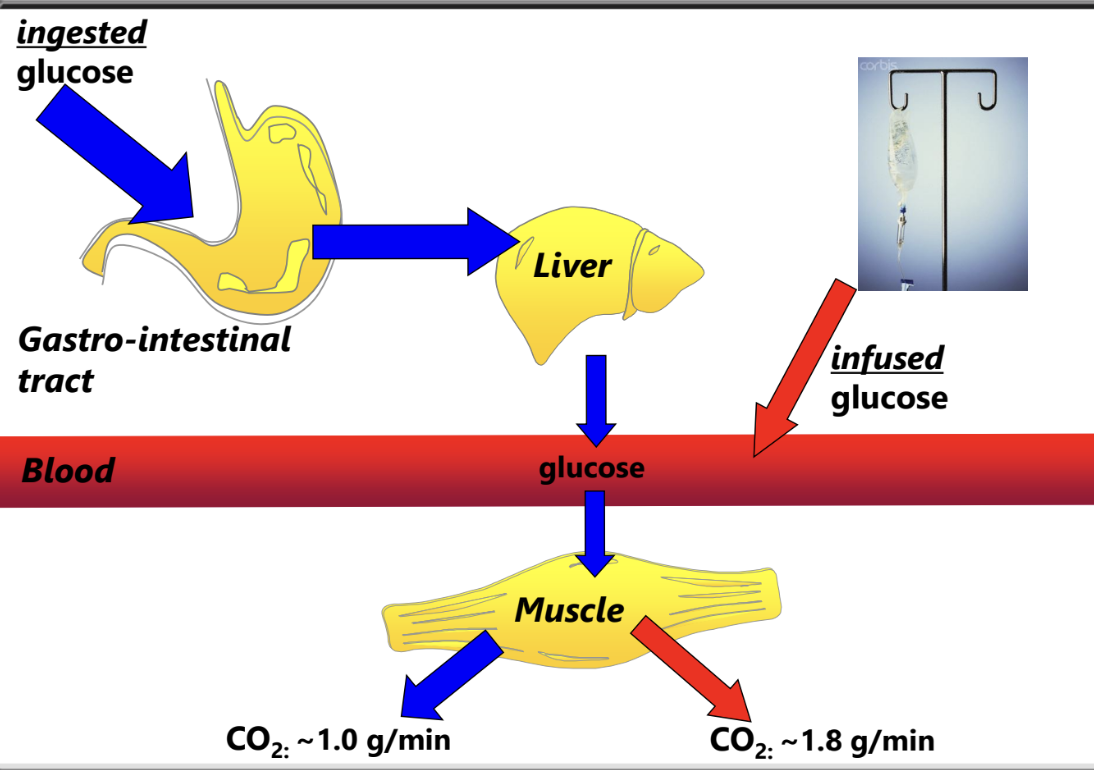
-if you infuse glucose instead of consuming glucose
higher rate of blood glucose oxidation
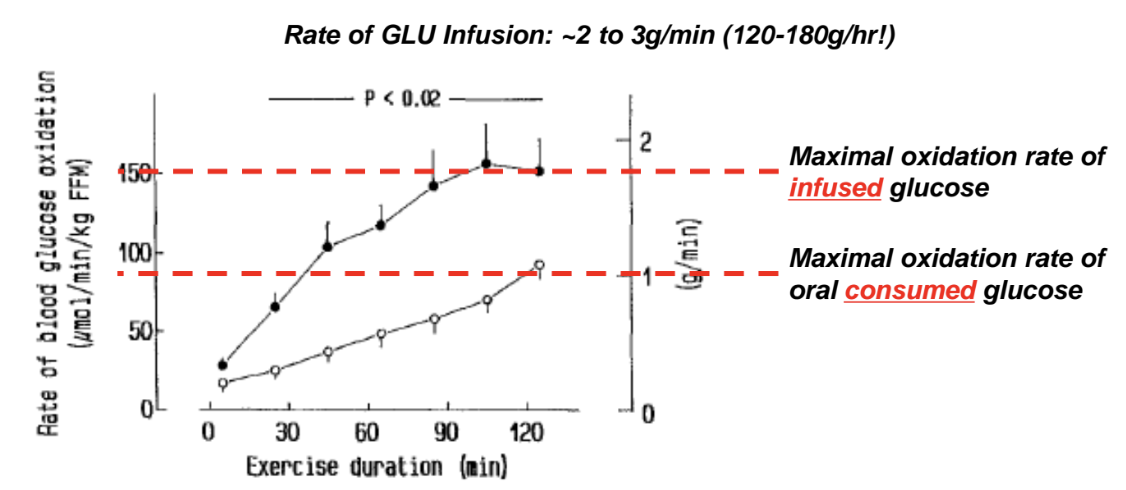
-glucose & fructose have 2 transporters
GLUT5
higher carbohydrate oxidation
-glucose & fructose gives best results
glucose + fructose → 56 minutes for athletes to complete cycling
glucose → 60 minutes for athletes to complete cycling
placebo → 67 minutes to complete cycling
Sport Drinks
-moderate concentration of glucose : fructose
-what sports drinks athletes should choose
sports drink/gel practiced with & adapted to
same drink available on race day
sports drink that still tastes good after practicing
flavour that athlete won’t be tired of
if strawberry & banana only available → won’t be wanting the exact same flavour after race
Individual CHO “Sweet Spot”
-increased intake = increased oxidation = increased performance
-sweet spot ~ 70 g CHO/hr
varies amongst athletes
-GI problems at 120 g CHO/hr
-every athlete is accustomed to a different amount of CHO
impaired performance
too much carbohydrate & fluid intake
leads to GI disorders
throw up
Practice Fueling & Hydration Sweat Rate Tracking during Long Runs
-practice rule of 15
~15-25 g CHO every ~15-25 min
~150-200 mL of fluids
-practice fueling & hydration in long sessions
-practice with different amounts of fluids & fuels
mimic timing of intake in race
Know & Practice Race Course
-practice at race intensities, durations, exercise mode, projected weather conditions & wind conditions
-different locations have different inclines
Boston - flat
NYC - hilly
Paris - hilly
-weather conditions affect run
heat affects GI tract more
-practice when/where in course you’ll be able to fuel & hydrate
know how long into race should fuel → where breaks/tents will be
Resistance Training
-act of repeated voluntary muscle contractions against a resistance greater than those normally encountered in activities of daily living
-voluntary contractions on purpose
lifting a load greater than normal activities
could be any type of resistance → heavy enough that muscle is putting in work
barbell, resistance bands, dumbbells
-to get stronger/bigger/better at doing things
-good for bone health
-makes us healthier
-improvement in quality of life and aging benefits
Effects of Resistance Training
-more you lift → stronger you get
-when you start to lift
neural adaptations (neurons) occurs first
better at turning muscles on
“newbie” gains
muscle undergoes hypertrophy
muscle grows
takes longer for muscles to grow
Resistance Training Program Variables
-load
heavy load
lift less times
light load
lift more times
-volume
sets & reps
-exercise sections
-frequency
how often you train
how many times you rest during exercise
-type of exercise
-range of motion
-effort
how hard you are trying
lifting a load very heavy that can only be lifted once → high effort
lifting a load you can lift 15x but only lifting it 10x → low effort
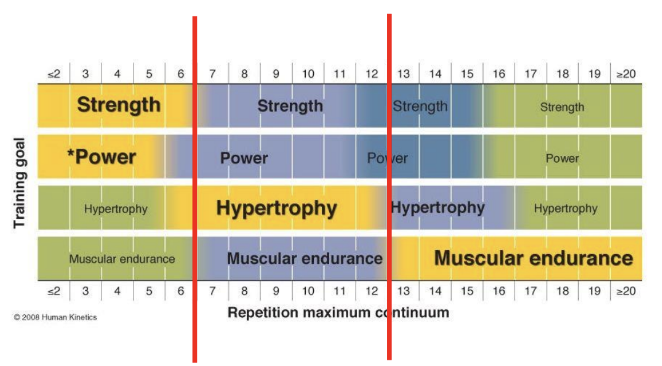
maximize hypertrophy → 8-12
maximize strength → 2-6
muscular endurance → 13 - 20+
Strength
-maximal ability to generate force regardless of speed
-high load = close to peak strength
-low load = far from peak strength
need to do more reps
-lift heavy → neural adaptations most important
Hypertrophy
-increase in size of muscle fibers
Absolute Endurance
-lifting a certain amount of weight and keeping it up for a certain time
ex: if you have the same load for 2 people pre or post training, who can lift the most times. This is more important, bigger stronger people have bigger absolute endurance
-total work which can be completed with same absolute load
-moving → 2 people carrying couch up the stairs
whoever can hold it longer has higher absolute endurance
-to build endurance for heavy load: getting stronger is better
-to build endurance for light load: more reps is better
-to be better at muscle endurance: getting stronger is better
Relative Endurance
-figuring out how many reps one can do with for example 30% of their 1 RM. Stronger people can lift harder. This is not as helpful, if someone gets stronger and they test at the same % RM, they will be lifting a greater absolute load
-total work that can be completed with same relative load (%1RM)
Quadriceps Hypertrophy
-doesn’t matter if you lift light load or heavy load
load isn’t important for hypertrophy
-as long as you build to the point where you can’t go anmore
-volume is important for hypertrophy → doing more → better for growing muscles
Metabolic Rate
-rate at which body expends energy or burns calorie
-anabolism, catabolism
Anabolism
-growth
-set of metabolic reactions that require energy to synthesize new molecules from simple precursors
-food intake sparks anabolism through biosynthetic pathways
Catabolism
-set of destructive metabolic reactions that transforms fuels into cellular (chemical) energy
glycolysis — breakdown of glucose/glycogen to pyruvate
glycogenolysis — breakdown of glycogen to glucose
Energy Extraction from Food
Digestion, Absorption and Transportation of Energy Yielding Nutrients
-carbohydrates — appear in body as simple sugars (glucose)
-fats — appear in body as fatty acids & glycerol
-proteins — appear in body as amino acids
-majority of foods we eat have carbohydrates, fats, proteins
-absorbed through the digestive tract and transported via the bloodstream to cells for energy use or storage
Production of Metabolites
-metabolites play key roles in cell’s energy production processes
-nutrients are further broken down in cells through metabolic pathways like glycolysis, beta-oxidation and protein catabolism
Cellular Energy Production (ATP Synthesis)
-metabolites are processed in mitochondria to produce ATP
primary energy currency of cell
-ATP produced through oxidative phosphorylation in electron transport chain and citric acid cycle
-ATP used by cells for various metabolic processes
including muscle contraction, active transport, biosynthesis
-ATP enables all of the cell’s energy-dependent activities to occur efficiently
Glycogen
-blood (4g glucose)
for a healthy individual (no diabetes)
-storage form of glucose = glycogen
body stores around 500g of glycogen in body
skeletal muscle (300-400g)
liver (75-100g)
-every 1g of glycogen is stored with approximately 3g of water
-glycogen stores will support moderate intensity exercise for 90 minutes or higher intensity exercise for ~30-45 minutes
-to eat before exercising?
depends on how long you exercise for
moderate intensity at 90 minutes → probably not
high intensity at 30-45 minutes → probably should
ATP decreases → not as high of intensity after 45 minutes
body burning through glycogen stores and need to replenish the stores
Fat
-good fat
avocados, fish, nuts, seeds, vegetable oils
-bad fat
-1g of glycogen = 4 kcal
500g of glycogen = 2000 calories
-fat is hydrophobic; can store a lot of fat (energy reserves)
storage of fat is unlimited
-fat not a good fuel for high intensity athletes
Protein Recommendations for Athletes
-1.2-2g/kg/day
-consume 0.25 – 0.3 g protein/kg/eating occasion approx. every 3 hours
-consume 0.25 – 0.3 g protein/kg shortly after exercise
-consume ~30g casein protein source before bed
-high protein diet
~20 g of protein equal to
3 oz meat
2 eggs
1.5 cup milk
½ can tuna
¾ cup beans or lentils
½ cup cottage cheese
1 cup yogurt
1/3 pack tofu
Nutritional Supplementation
-athletes were using supplements to help with their performance
-supplements are not drugs nor stimulants
-have a natural health product (NHP) number
Why Nutritional Supplements are Problematic
-supplements not heavily regulated like drugs
not under the same scrutiny as drugs
not governed the same as drugs
-supplement companies don’t have to prove their claims up front
-doses of some ingredients may not be specified
-quality and composition may vary
Anabolic Steroids and Nutritional Supplements Study
-634 non-hormonal nutritional supplements from 13 countries purchased and tested
289 from prohormone selling companies
345 from companies that didn’t sell prohormones
-results
11 anabolic, androgenic steroids
15% contained prohormones when none of the products should have prohormones
10% couldn’t be analyzed
→ supplements not properly governed
Supplements in Sport
-food first, supplements second
-athletes subject to anti-doping and WADA code
-athletes responsible for what they take
-athletes may use supplements for justifiable reasons beyond a direct impact on sports performance such as in case of illness, travel or high volume training
-nutritional supplements pose a high risk for banned subs
-small number of supplements with good evidence behind them that athletes can trial with right guidance
-small number of supplements are beneficial to athletes and must carry these endorsements

manufacturers can send their products to these companies and see if their products contain any banned substances
if approved then these companies will endorse/allow the labels to be put on their packaging
World Anti-Doping Agency (WADA)
-prohibited list is updated every year
-signatories to code include (groups that sign onto the code)
Olympic & Paralympic Sports and committees
events (commonwealth games)
ex: netball not part of Olympics but it is a commonwealth game
FIFA, cheerleading, MMA, karate, rugby, australian football
exceptions: MLB, NBA, NFL
internal drug policies
The Prohibited List
-drug has to meet 2/3 criterias to be banned
taking it must enhance or potentially enhance performance
place an athlete’s health at risk
violate the spirit of sport
ex: swimmers used special compression suits to make them swim faster
*masking agents/not approved for human use → also prohibited
substances prohibited at all times
non approved substances, anabolic agents; peptide hormones, growth factors; related substances and mimetics; beta-2 agonists; hormone & metabolic modulators; diuretics and masking agents
diuretics — allow people to make a weight class
hormones — helps with growth of bones & muscles
testosterone -- builds muscle mass
prohibited methods
manipulation of blood, chemical and physical manipulation (including IV infusions), gene and cell doping
substances & methods prohibited in competition
stimulants: narcotics, cannabinoids
CBD removed from list in 2018
immediate test on athletes to see if substance is in athlete’s system
substances prohibited in particular sports
beta-blockers — helps with precision & heart rate (makes you more calm
high skill with low intensity
golf, archery, darts
Caffeine
-not a diuretic
increased liquid is the main contributor to increased urine
-crosses blood brain barrier
fat-soluble
passes quickly into brain
affects central nervous system
-adenosine receptor antagonist
blocks adenosine receptors
binds to adenosine receptor itself so that adenosine can’t bind to the adenosine receptor
adenosine promotes sleepiness & relaxation
blocked receptors = feeling alert & energized
-increases neural activity
stimulates release of dopamine & norepinephrine
increases focus, concentration and wakefulness
impacts serotonin
improves mood & motivation
-peak levels
45 minutes after consumption
-half-life
5 hours
large range — caffeine can affect your body for several hours
-genetic variability
in activity of CYP1A2 among individuals
use CYP1A2 well → fast metabolizers of caffeine
drink coffee 30 minutes before sleeping → able to sleep → fast metabolizers of caffeine
don’t use CYP1A2 well → slow metabolizers of caffeine
drink coffee 30 minutes before sleeping → unable to sleep → slow metabolizers of caffeine
Caffeine Intake
-Health Canada
shouldn’t exceed 400 mg of caffeine per day on a regular basis
including energy drinks
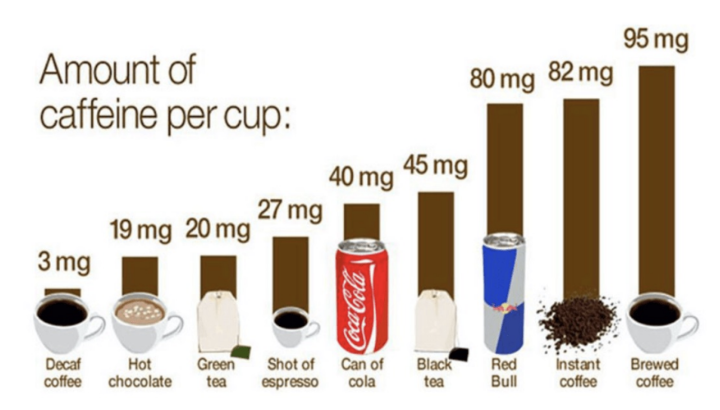
Energy Drinks
-beverages containing stimulants (caffeine) marked as products that enhance mental and physical performance
often include ingredients like ginseng, taurine, herbal extracts
regular use may mask poor nutritional practice or underlying health concerns (issues with sleep)
-lots of additives, sugar
Protein Intake
-Canada RDA for protein is 0.8 g/kg/day
-1.6 g/kg/day to maximize protein when lifting
2x the RDA
or 20+ g per meal/snack
-not everyone get benefits of protein
some people get big with carbohydrates
-protein intake has a moderate effect on muscle gains following resistance training
-protein intake has a small effect on strength gains following resistance training
Essential Amino Acid Content
-plant proteins are lower in quality
-proteins high in leucine are better
quality & leucine content is important
-casein is digested slowly
-whey has good amino acid profile
faster than casein
more muscle protein synthesis
gets amino acids quickly into body
Anabolic Window for Proteins
-right after workout/close in proximity to workout
lose out on gains if you wait
-real food works better than proteins from supplements
better for muscles & body
-don’t need protein supplements to get big & strong
but they’re not bad if you do take it
Muscle Full Effect
-infusing amino acids at a custom rate. Muscle protein synthesis increases with increased amino acids. As they kept infusing amino acids, participants had high amino acids but muscle protein synthesis went down to baseline after ~ 2-3 hours (muscle full effect). This is why can't eat protein all the time to get bigger muscles; we need exercise to increase muscle size (lifting/resistance exercise) and periods when we do not eat for a while